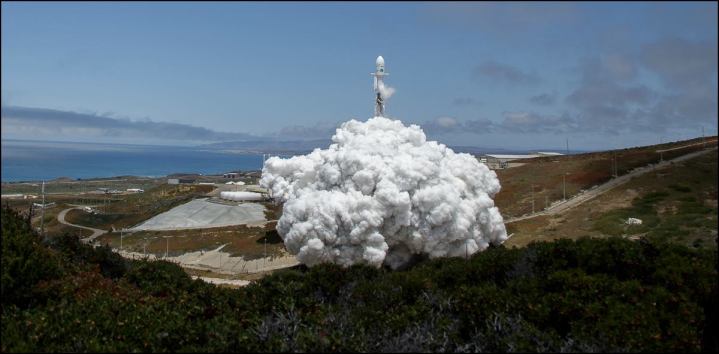
Getting to space is hard. Really hard, in fact. There’s just not a lot of room for error. For every space flight that’s ever gone smoothly, there are dozens of botched missions that remind us how fine the line is between success and failure. To make things worse, when things do go wrong with a rocket launch, it usually doesn’t end pretty. Catastrophic crashes and violet explosions are common, and unfortunately so is the loss of lives. We’ve combed through space flight history and found some of the most massive rocket crashes ever caught on film.
Vanguard Text Vehicle 3
December 6, 1957
In 1957, the space race was beginning and the US and Russia were in a race to be the first to make headway into this new frontier. After Russia launched its first satellite in October 1957, the US was poised to deploy its first satellite a few months later. Unfortunately, this much-hyped launch failed before it went airborne.
Titan 1
December 12, 1959
The Air Force’s Titan rocket was a staple of the US space program from 1959 to 2005, but its early flights were rocky. This test launch of theTitan 1 rocket exploded a mere 4 seconds after engine ignition and engulfed the launch pad in a giant fireball. Thankfully, there were no injuries from the explosion.
Space Shuttle Challenger
January 28, 1986
NASA’s Space Shuttle Challenger was on its 10th flight when it exploded 73 seconds into its flight. More than 17 percent of Americans, many of them schoolchildren, saw the explosion live because of Christa McAuliffe, who would have been the first teacher in space. The disaster was the result of failing O-rings that were not designed for the cold conditions present on that particular day.
Titan 34D-9
April 18, 1986
The beginning of 1986 was rough for the US space program. The year opened with the devastating loss of the Space Shuttle Challenger. Then in April, the Titan 34D exploded in one of the worst space launch disasters at the time. A few seconds after launch, the rocket, and its KH-9 spy satellite payload, burst into flames and showered the launch complex with fiery debris and toxic propellant. Instead of O-rings, this failure was the result of weak joints that held the booster rocket segments together.
Chinese Long March rocket CZ-3B
February 15, 1996
The US is not the only country with explosive rocket crashes. China has had its fair share, including the devastating Long March rocket, which exploded over Sichuan, China and killed hundreds of people. Shortly after launch, the rocket veered off course because of an error in the guidance system. The fuel-laden rocket then headed directly towards a nearby village. The recorded video shows not only the crash but the devastating aftermath.
Air Force Delta 2
January 17, 1997
The Air Force had big plans when it launched an uncrewed Delta II rocket on January 17, 1997. The $55 million rocket was carrying a $40 million GPS-II navigational satellite, one of the first of the second generation GPS satellites to be deployed. Unfortunately, the rocket and its payload exploded 13 seconds after liftoff.
Titan IV
August 12, 1998
The Titan IV rocket was the last Titan model used by the Air Force before the rocket series was officially retired in 2005. One of the worst accidents involving this model happened on August 12, 1998, during the launch of a Mercury spy satellite. Shortly after takeoff, the Titan IV exploded in a giant fireball that destroyed both the rocket and its sensitive military payload. The total financial loss from the failed mission exceeded $1 billion.
Proton-M
July 2, 2013
Russia’s proton rocket was slated to carry three satellites for the GLONASS navigation system, but the rocket and its payload never made it to their destination. Seconds after takeoff, the rocket veered in one direction and then turned in the opposite direction before finally plummeting back to earth.
Antares 130
October 28, 2014
Orbital Sciences Corporation was ready to debut their new version of their Antares rocket, the Antares 130, but the launch did not proceed as planned. Within seconds of liftoff, the rocket and its payload burst into flames and caused a massive explosion when it hit the ground. The Antares 130 was carrying the Cygnus CRS-3 uncrewed spacecraft and supplies for astronauts on the International Space Station. The crash was attributed to Orbital’s use of refurbished Soviet engines that were built in the 1970s. A manufacturing flaw in the engine and poor long-term storage were contributing factors in the crash.
Interstellar Technologies MOMO-2
June 30, 2018
Interstellar Technologies is Japan’s version of SpaceX. It is the first private company to launch a rocket in Japan and hopes to become the first Japanese company to launch a rocket into space. The company’s first two launches haven’t fared so well The first suborbital rocket, the MOMO-1, failed 66 seconds after launch, while the second rocket, the MOMO-2, crashed violently four-seconds after launch. Despite these setbacks, the company is earnestly working on the future MOMO-3and a new orbital rocket.
Space X
2013-2016
SpaceX has had a singular focus since it was founded in 2002. The company has dedicated itself to reducing space transportation costs by developing reusable rockets. This development process has had its fair share of ups and downs. Never one to take things too seriously, Space X founder Elon Musk released this short compilation of the company’s most dramatic crashes.
Editors' Recommendations
- Sony’s first drone, the Airpeak S1, rockets to 55 mph in just 3.5 seconds
- SpaceX will use a different kind of stainless steel for its Starship rockets
- Blue Origin offers a peek at its enormous next-gen rocket nose cone
- Daredevil ‘Mad Mike’ Hughes dies in launch of latest homemade rocket
- Watch SpaceX nail in-flight escape test, and lose a rocket in a huge fireball



